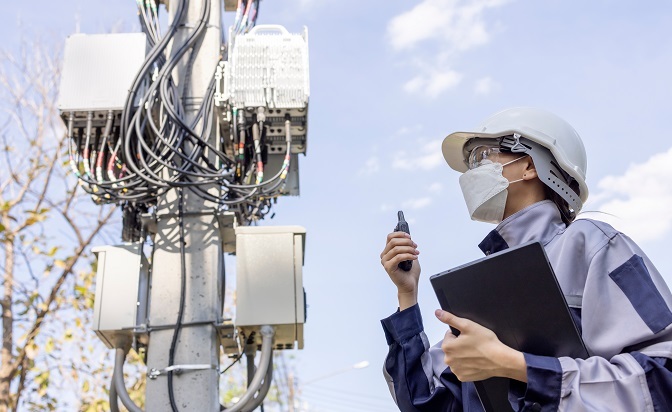
 Data Structure
Data Structure Networking
Networking RDBMS
RDBMS Operating System
Operating System Java
Java MS Excel
MS Excel iOS
iOS HTML
HTML CSS
CSS Android
Android Python
Python C Programming
C Programming C++
C++ C#
C# MongoDB
MongoDB MySQL
MySQL Javascript
Javascript PHP
PHP
- Selected Reading
- UPSC IAS Exams Notes
- Developer's Best Practices
- Questions and Answers
- Effective Resume Writing
- HR Interview Questions
- Computer Glossary
- Who is Who
What is the full form of FDD?
Introduction
Frequency Division Duplex (FDD) is a method of wireless communication that allows for simultaneous two-way communication between two devices by using two separate frequency bands, one for transmitting and one for receiving.

The transmitting and receiving frequencies are typically separated by a defined frequency gap, called the duplex spacing, which allows the two signals to coexist without interfering with each other.
In FDD, data can be transmitted and received simultaneously, which enables full-duplex communication, making it an ideal choice for many wireless communication applications such as cellular networks, radio communication systems, and satellite communication systems.
Applications of FDD
Frequency Division Duplex (FDD) has numerous applications in wireless communication systems, some of which are
Cellular Networks FDD is widely used in cellular networks for voice and data communication. In FDD, the uplink and downlink frequencies are separated by a duplex spacing, which allows for simultaneous communication in both directions.
Satellite Communication FDD is also used in satellite communication systems for two-way communication between the earth station and the satellite. The earth station transmits signals on an uplink frequency, and the satellite receives the signals and retransmits them on a downlink frequency.
Radio Communication Systems FDD is used in radio communication systems, such as walkie-talkies, two-way radios, and cordless phones. These systems use FDD to allow for simultaneous communication in both directions.
Wireless Local Area Networks (WLANs) FDD is used in WLANs to enable simultaneous bi-directional communication between devices. FDD is used in the 802.11a/b/g/n wireless standards for WLANs.
Cable TV Networks FDD is used in cable TV networks to enable bi-directional communication between the cable modem and the cable headend. The cable modem uses one frequency to send data to the headend and another frequency to receive data from the headend.
Advantages of FDD
Frequency Division Duplex (FDD) offers several advantages in wireless communication systems, including
Full-Duplex Communication FDD allows for simultaneous bi-directional communication, enabling full-duplex communication. This means that data can be transmitted and received at the same time, which increases the efficiency and capacity of the communication system.
Reduced Interference FDD uses separate frequency bands for transmission and reception, which reduces interference between the two signals. The duplex spacing ensures that the transmitted and received signals do not interfere with each other, providing better signal quality and higher reliability.
Better Quality of Service FDD provides a better quality of service compared to other communication methods such as Time Division Duplexing (TDD). FDD ensures that each device has dedicated bandwidth for both transmission and reception, which minimises delays and provides a more reliable connection.
Compatibility with Existing Infrastructure FDD is compatible with existing communication infrastructure and can be easily integrated into existing networks. This makes it a cost-effective solution for upgrading and expanding existing communication systems.
Higher Data Rates FDD allows for higher data rates compared to other communication methods. By using separate frequency bands for transmission and reception, FDD provides more bandwidth, which enables faster data transfer rates.
Differences between FDD and TDD
Frequency Division Duplex (FDD) and Time Division Duplexing (TDD) are two different methods of wireless communication. The main differences between FDD and TDD are
Frequency Allocation In FDD, separate frequency bands are allocated for transmission and reception, while in TDD, the same frequency band is shared for both transmission and reception.
Time Allocation In FDD, time is not used as a means of allocation, while in TDD, time is used to allocate the same frequency band for both transmission and reception.
Duplex Spacing In FDD, there is a defined frequency gap between the uplink and downlink frequency bands, which prevents interference between the transmitted and received signals. In TDD, there is no frequency gap as the same frequency band is shared between transmission and reception, but time is allocated for switching between transmission and reception.

Efficiency FDD offers full-duplex communication, allowing simultaneous bi-directional communication, while TDD offers half-duplex communication, meaning that data can only be transmitted or received at any given time.
Capacity FDD provides a higher capacity than TDD, as it offers dedicated frequency bands for transmission and reception, enabling faster data transfer rates.
Compatibility FDD is more compatible with existing infrastructure, while TDD requires more specialised equipment and infrastructure.
FAQs
1. What is Frequency Division Duplex?
Ans: Frequency Division Duplex (FDD) is a method of wireless communication that allows for two-way communication between two devices by using separate frequency bands for transmission and reception. In FDD, the transmitter and receiver each use different frequencies to send and receive data, which enables simultaneous bi-directional communication.
2. Why is Frequency Division Duplex important?
Ans: Frequency Division Duplex (FDD) is important in wireless communication because it enables two-way communication between two devices simultaneously, which improves the efficiency and capacity of the communication system.
3. What are the disadvantages of Frequency Division Duplex?
Ans: Frequency Division Duplex (FDD) offers some disadvantages, including Spectrum Efficiency, Cost, Latency and Interference.

